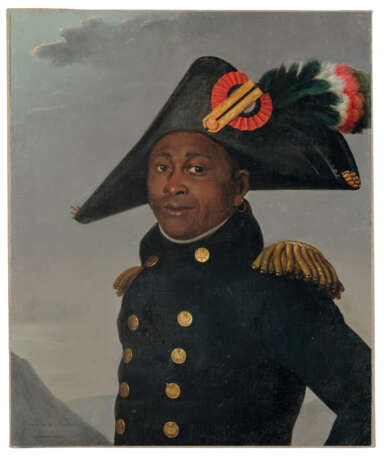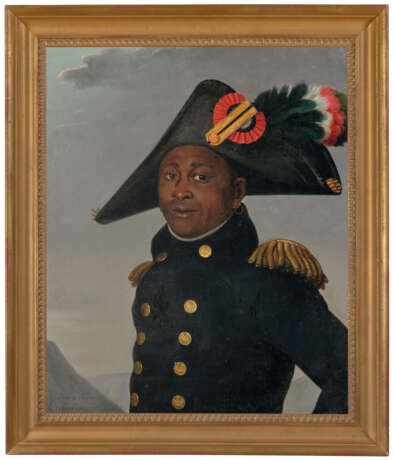ID 1336097
Лот 37 | COMTE ALEXANDRE FRANÇOIS LOUIS DE GIRARDIN (PARIS 1767-1848 AVRANCHES)
Оценочная стоимость
€ 200 000 – 400 000
Portrait de François-Dominique Toussaint Louverture (1743-1803) portant un chapeau orné d'une cocarde, en buste
signé, localisé et daté 'Girardin a Nantes / an . 13eme' (en bas, à gauche)
inscrit 'Toussaint Louverture' (au revers de la toile d'origine)
huile sur toile
65 x 54,3 cm (25 ½ x 21 1/3 in.)
Provenance
Angela Gross (1932-2022) ; sa vente, Christie's East, New York, 15 mai 1991, lot 1.
Juan Portela (né en 1943), 138 East 71st Street, New York ; sa vente, Christie's, sur les lieux, 27 janvier 1993, lot 31 ;
Acquis au cours de celle-ci par l'actuel propriétaire.
Literature
P. Paumier, 'Figures de Toussaint Louverture : Monsieur Toussaint d’Édouard Glissant confronté au regard des historiens contemporains', [actes de colloque], N. Darbon (dir.), Littérature et musique, Caraïbes et Amazonie. Autour d’Édouard Glissant, Université de Rouen, avril 2012, pp. 3-4, reproduit en couleurs p. 4, fig. 11.
Center for the Study of Slavery and Justice, The Many Faces of Toussaint L’Ouverture and the Haitian Revolution, [brochure accompagnant l'exposition The Other Revolution: Haiti, 1789-1804, New York, 2014], p. 1, reproduit en couleurs.
WEBOGRAPHIE SELECTIVE
D. Geggus, 'Iconography', The Changing Faces of Toussaint Louverture. Literary and Pictorial Depictions [en ligne], 2013, https://www.brown.edu/Facilities/John_Carter_Brown_Library/exhibitions/toussaint/pages/iconography.html (consulté le 4 octobre 2024).
B. MiNiMuM, 'L’Ouverture de Toussaint, création musicale historique et panafricaniste', AuxSons [en ligne], 21 février 2022, https://www.auxsons.com/en/breves/louverture-de-toussaint-creation-musicale-historique-et-panafricaniste/ (consulté le 30 septembre 2024).
M. Rachedi, 'Haiti’s "Black Spartacus": Toussaint Louverture and abolishing slavery', The Africa Report [en ligne], 23 octobre 2020, https://www.theafricareport.com/47223/haitis-black-spartacus-toussaint-louverture-and-abolishing-slavery/ (consulté le 30 septembre 2024).
Babelia, 'El esclavo revolucionario que liberó Haití, el imperio chino del litio, una manicura reveladora y otros libros de la semana', El País [en ligne], 11 mai 2024, https://elpais.com/babelia/2024-05-11/el-esclavo-revolucionario-que-libero-haiti-el-imperio-chino-del-litio-una-manicura-reveladora-y-otros-libros-de-la-semana.html# (consulté le 30 septembre 2024).
Anonyme, 'Toussaint Louverture', Wikipedia [en ligne], 24 septembre 2024, https://en.wikipedia.org/wiki/Toussaint_Louverture (consulté le 30 septembre 2024 - erronément daté 1813).
Anonyme, 'Toussaint L’Ouverture', National Portrait Gallery [en ligne], https://www.npg.org.uk/collections/toussaint-louverture (consulté le 30 septembre 2024).
P. Sylvain, 'Is this the authentic face of Toussaint L'Ouverture?', Boston Haitian Reporter [en ligne], s. d., https://www.bostonhaitian.com/2011/authentic-face-toussaint-louverture (consulté le 30 septembre 2024).
G. Sorman, 'Why Toussaint Louverture Needs to Be Taught in School', France-Amérique [en ligne], 17 août 2021, https://france-amerique.com/why-toussaint-louverture-needs-to-be-taught-in-school/ (consulté le 30 septembre 2024).
L. D. Oruno, 'Toussaint Louverture', France Archives [en ligne], s. d., https://francearchives.gouv.fr/fr/pages_histoire/39647 (consulté le 30 septembre 2024).
Further Details
ALEXANDRE FRANÇOIS LOUIS, COUNT OF GIRARDIN (1767-1848), PORTRAIT OF FRANÇOIS-DOMINIQUE TOUSSAINT LOUVERTURE (1743-1803) WEARING A HAT WITH A COCKADE, BUST-LENGTH, OIL ON CANVAS, SIGNED, LOCATED AND DATED (LOWER LEFT), INSCRIBED (ON THE REVERSE)
Toussaint Louverture (1743-1803), nicknamed the Black Spartacus, was the emblematic figure of the Haitian Revolution, the first successful slave revolt in the modern world. With his highly evolved ideology, he preached the ideas of fraternity and innate freedom, long before the dictum of the French Revolution.
As far as we know, this is the first portrait of the great hero of the revolt executed in oils. Painted in year 13 of the revolutionary calendar (September 1804-September 1805), it follows in the tradition of Western portraiture by presenting Toussaint as the worthy equal of the French generals. This would have been a powerful choice a year after his death, as he had been condemned by Napoleon (1769-1821) to languish in prison in the aim of breaking him both physically and psychologically.
THE LIFE OF TOUSSAINT LOUVERTURE
I am Toussaint Louverture; you may have heard my name. I have undertaken the vengeance of my race. I want freedom and equality to reign in Saint-Domingue. I am working to bring them into existence. (Toussaint Louverture, Proclamation of Camp Turel, 29 August 1793).
Born a slave around 1743 in the Bréda habitation of Haut-du-Cap in the French colony of Saint-Domingue, now Haiti, Toussaint, or to give him his full name, François-Dominique Toussaint Louverture, belonged to the Louis-Pantaléon de Noé family. He served as coachman to his protector, the procurator Bayon de Libertat (c.1732- c.1802), who is said to have granted him ‘savannah liberty’, freedom of movement without emancipation, before finally emancipating him at an unknown date, before 1776. He always remained very grateful to Bayon de Libertat and would help his family to flee their plantation during the height of the Revolution in 1791.
At this time, the colony of Saint-Domingue was the richest in the West Indies, the world's leading producer of sugar and coffee. However, this wealth was based on the 160,000 or so slaves who worked on the plantations. As a result, the Declaration of the Rights of Man of 26 August 1789 seemed dangerous to the island's colonists: the revolutionary ideas coming out of metropolitan France had a strong influence on the slaves, who were already ready to revolt against their masters. In August 1791, the Bois-Caïman ceremony took place, seen as the founding act of the Haitian Revolution, and before the end of the year, the army of black insurgents controlled large areas of land as far as the border with the Spanish part of the island, Santo Domingo (fig. 2).
Toussaint did not play an important role in this first phase of the revolution. However, he knew the leaders well and helped them to organise their forces. Unlike most slaves, Toussaint could read and write and was familiar with the ideas of Machiavelli (1469-1527), Montesquieu (1689-1755) and Rousseau (1712-1778), among others, which helped him to coordinate a disciplined European-style defence. It was also at this time that he began to be known for this magnanimity, a trait that he retained until the end of his life, in his treatment of the whites imprisoned by the rebel army.
In the spring of 1793, the Spanish offered Toussaint and his army of around 4,000 former slave a sanctuary on the Spanish side of the island. Toussaint's military talents were quickly noticed by his hosts and he was promoted by them to lieutenant-general. However, in May 1794, he decided to join the French republican camp, which had become more attractive to former slaves thanks to the proclamation of general liberty on the island by Léger-Félicité Sonthonax (1763-1813) in August 1793 (undoubtedly one of the most important acts in the development of human and civil rights, yet little studied). For Toussaint, this decision was also very personal: in Étienne Maynaud de Lavaux (1751-1828), the new governor of Saint-Domingue, he saw someone who believed as he did in the emancipation of the black population and in a true form of republicanism.
With the help of Toussaint and his men, the French succeeded in defeating the Spanish in 1795. The Spaniards ceded Santo Domingo to the French, a decisive blow that brought major economic benefits for France, which now controlled all the island's agricultural production. As a reward for his efforts, Toussaint was put in control of the northern province, with the exception of Cap-Français, and was appointed brigadier general. His loyalty to Lavaux earned him a promotion to Major General and Lieutenant Governor of Santo Domingo the following year, making him the second most powerful person on the island behind Lavaux himself. Toussaint took advantage of his new power to have Lavaux and Sonthonax elected as deputies, clearing the way for him to become commander of the army of Saint-Domingue in May 1797.
Around 1796, Toussaint's power became more complicated. Theoretically, he could be considered a moderate, with the belief at the heart of his ideology in true republican unity, where the white, black and mulatto population would find perfect equality. However, this belief caused him problems: he was considered too progressive for some, and too reactionary for others. Under his rule, he restored many elements of the Ancien Régime and included white men in his ‘court’, which was frowned upon by his black peers. He also understood that the production of coffee and sugar had to continue if Saint-Domingue was to succeed as an independent state. However, when he asked former slaves who had not joined the army to return to work, they revolted, seeing this as a return to slavery.
His policy towards France was also complicated. In 1798, he negotiated the surrender of the British still occupying the west of the island, and opened the ports of Saint-Domingue to British merchant ships, even though Metropolitan France was still at war with Great Britain. With the coup d'état of 18 brumaire an VIII (9 November 1799), which marked the start of the Consulate, the republican isonomy of the colonies was abolished and Napoleon appointed Toussaint captain-general of Saint-Domingue, making him the colony's second-in-command after France's legal representative there. Toussaint went one step further, writing Saint-Domingue’s first autonomous constitution, which appointed him governor for life. At the same time, the Spanish part of the island, which had been officially French since 1795, was invaded by Toussaint. In the space of a decade, the former slave had managed to rise to the political head of Saint-Domingue and establish a new order that benefited black people.
However, when Napoleon, who was working towards a Franco-Spanish peace in Europe, heard the news of his captain-general's invasion of Santo Domingo, Toussaint began to be seen as a threat, and the First Consul sent an expeditionary force to the West Indies to put an end to the emancipation of the Dominican people. By this date it was not only the French who regarded Toussaint and his revolutionaries as a danger: letters from Thomas Jefferson (1743-1826) describing them as ‘cannibals of the terrible Republic’ demonstrate the fear of seeing a similar revolt occur in the United States (letter to Vice-President Aaron Burr (1756-1836), 1799 [see S. Hazareesingh, Black Spartacus, London, 2020, p. 3]).
The Napoleonic corps, under the command of General Charles Leclerc (1772-1802), landed simultaneously in all the island's major ports. However, the first book to be written on Toussaint's life emphasises that ‘it is on him and not on the inhabitants of St. Domingue, led astray by his suggestions, that France ... wishes to take revenge’, showing the extent to which he had become the incarnation of the revolution throughout the world (C. Cousin d'Avallon, Histoire de Toussaint-Louverture, Paris, 1802, p. vi). Despite heavy losses among the French troops, Toussaint was quickly defeated and capitulated in May 1802. He was deported to France in June 1802 with his family and around a hundred of his closest supporters. Instead of being brought to trial, he was sent to the chateau de Joux in total secrecy, where he died of pleuropneumonia on 7 April 1803.
With the fall of Toussaint, the Haitian Revolution came to a momentary standstill. His former lieutenant Jean-Jacques Dessalines (1758-1806) and other militants of the revolt nevertheless continued to fight for the freedom of the black population. After the departure of the French, Dessalines restored the Indian name of Haiti to Saint-Domingue and proclaimed the republic on 1 January 1804. The Haitian Revolution thus became the most radical political transformation of the 18th century.
By overthrowing me, you have only cut down the trunk of the tree of freedom; it will grow back because its roots are deep, numerous.
These are the words Toussaint Louverture is said to have uttered on 7 June 1802, as he was about to board Le Héros, the ship which was carried him to France and death. He would have been right. Sudhir Hazareesingh describes Toussaint as the first black superhero of the modern era (S. Hazareesingh, ibid, p. 329), and without exaggeration. Just to give one example of this status, during the American Civil War, Toussaint was for African Americans the cornerstone of a transatlantic identity, linking their violent struggle for freedom and equality to a black revolutionary tradition deeply rooted in the Atlantic world of the eighteenth century. His name was given to certain regiments during the war, such as the Morgan Guards in Massachusetts, a black militia initially named after a white patron, renamed the Toussaint Guards in 1863.
TOUSSAINT LOUVERTURE’S ICONOGRAPHY
The only known depictions of Toussaint that were executed during his lifetime are all engravings, and these all date from after 1802. These works can be divided into two distinct groups: caricatures and portraits depicting him as a great man. In both categories, there is not a single work that is executed from life.
It is perhaps not surprising that, from 1802 onwards, many British artists decided to celebrate Toussaint, on the principle that the enemy of my enemy is my friend. A famous etching by the Scottish artist John Kay (1742-1826), dated 1802, shows Toussaint, then leader of the Haitian army, in the pose of the Apollo of Belvedere (fig. 3). There is also an etching showing him as Governor of Saint-Domingue. Both images heroise Louverture, but they contain major faults in the depiction of the uniform, which more closely resembles the British model.
At the same time, the Lyonnais artist Denis Volozan (1765-1820), who had lived in Saint-Domingue between circa 1788 and 1791 (before moving to the United States), painted a watercolour of Toussaint (fig. 4), which seems to take as its model the famous painting executed in 1801 by Jacques-Louis David (1748-1825), Bonapart Crossing the Alps (Musée national du château de Malmaison, Rueil-Malmaison, Hauts-de-Seine), the first version of which was commissioned by the King of Spain as a token of the entente between his kingdom and the French Republic. Did Volozan understand the irony of reusing this image for the hero who drove the Spanish out of Santo Domingo? This we cannot know, but others did the same: we also know of a coloured etching of the same subject, dated 1802.
The present painting is exceptional because, to our knowledge, it is the first example of a portrait of Toussaint painted in oil. There is no doubt as to the sitter’s identity, as it is inscribed by Girardin (1767-1848) on the reverse of the original canvas ‘Toussaint Louverture’ (fig. 1). The question remains, however, as to Girardin's motives for painting the portrait of a man condemned by the First Consul, the painter being an officer of the National Guard, a Napoleonic loyalist who would be appointed Comte d'Empire in 1808. Further to this, is the question as to why Girardin chose to paint it in Nantes, one of the French cities most involved in the Atlantic slave trade and rigorously anti-abolitionist for the same reason.
The answer to these questions may be found in the artist’s youth; his father, René Louis de Girardin (1735-1808), was an admirer and great friend of Jean-Jacques Rousseau, who died in a pavilion on the family estate at Ermenonville, near Paris. As a result, young Alexandre would have grown up with the great philosopher's ideas, as found in the Social Contract.
Whatever angle we look at it from, therefore, the ‘right of slavery’ is null and void—not only as illegitimate but also as absurd and meaningless. The words ‘slave’ and ‘right’ contradict each other, and are mutually exclusive. (J.-J. Rousseau, Du Contrat social, I, 4, 1762).
This philosophy, taught from childhood, would have made a convinced abolitionist out of Girardin. Unfortunately, this remains a theory yet to be proven, but the evidence of the portrait itself is undeniable. Girardin followed to the letter the precepts of European portraiture, which required a portrait to embody the individual's relationship with society and the state, to play a social role and to allow viewers to perceive the character of the sitter. The image of Toussaint that the artist wanted to pass on to future generations was that of a French general, a kind, smiling man who looked at his interlocutor as an equal.
Toussaint was no less inspiring for the artists and writers of the 19th and 20th centuries. A lithograph by Nicolas-Eustache Maurin (1798-1850) published in 1832 became the main model for later artists. It was used in books and on posters, and was even used in 1938 in the Toussaint Louverture Series by Jacob Lawrence (1917-2000), an African-American painter who was one of the leading figures in the African-American cultural movement known as the Harlem Renaissance (fig. 5).
Representations of Toussaint are not confined to the world of art, however. His face also appears on stamps in Haiti, France and Cuba, on Haitian and Senegalese coins, and there are sculptures of him in France, Canada and Benin. Aimé Césaire (1913-2008), the French writer and politician, included him in his long poem Cahier d'un retour au pays natal (1956), in which he is ‘a lonely man imprisoned in white’, and dedicated an entire biography to him in 1960. In 1934, the Trinidadian historian C. L. R James (1901-1989) wrote The Black Jacobins, a play that brought Toussaint's story to the attention of the British public, before writing his pioneering book of the same name in 1938. The list goes on, demonstrating the profound influence that Toussaint Louverture continues to exert on the cultural and political world of today.
| Техника исполнения: | Масло на холсте |
|---|---|
| Художественный стиль: | Старые мастера |
| Жанр: | Портрет |
| Место происхождения: | Западная Европа, Франция, Европа |
| Категория аукционного дома: | Картины, Акварели, Рисунки, Картины |
| Техника исполнения: | Масло на холсте |
|---|---|
| Художественный стиль: | Старые мастера |
| Жанр: | Портрет |
| Место происхождения: | Западная Европа, Франция, Европа |
| Категория аукционного дома: | Картины, Акварели, Рисунки, Картины |
| Адрес торгов |
CHRISTIE'S 8 King Street, St. James's SW1Y 6QT London Великобритания | |
|---|---|---|
| Предосмотр |
| |
| Телефон | +44 (0)20 7839 9060 | |
| Комиссия | see on Website | |
| Условия использования | Условия использования |





